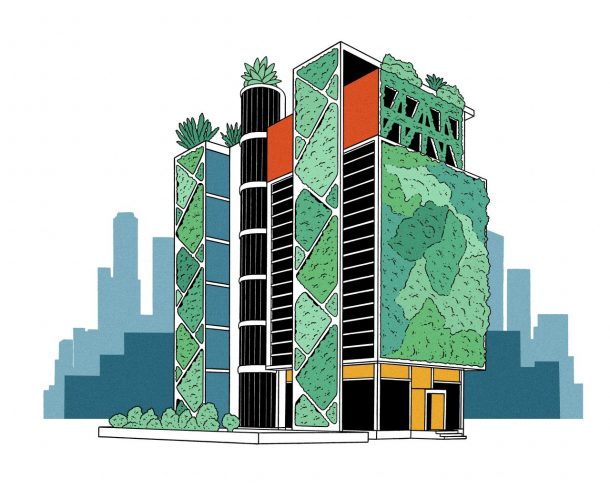
Future-proofing a city and sustainable design are ultimately about climate change resilience. We will need new developments to be green power stations in their own right rather than tap into the local grid; need new economic zones within city limits where fruits and vegetables can be grown on vertical towers or in rooftop gardens; and to rethink our use of space – to breathe new life into abandoned or underperforming buildings.
Creating a sustainable community is not one-size-fits-all. Current environmental, economic, cultural, spatial, technological and social issues must be considered, while also thinking of what might be needed in 20 to 50 years.
In Gävle, Sweden, the original 19th-century Läkerol candy factory, where the famous lozenges and pastilles were made, is being transformed into a mixed-use development. Pomeroy Studio was commissioned to design the complex’s two new residences for couples, young students, families and retirees, which means that the towers must be flexible to the needs of vastly different demographics, while also ticking all the future-proof boxes.
 We also had to adapt our tropical inside-outside design aesthetic to the Swedish way of life. We designed enclosed winter gardens that can completely slide back to create an open-air extension of the living space; perfect for residents to enjoy the Swedish summer months, which are getting warmer and longer. There are also sky courts and sky gardens, rooftop vegetable farms and a jigsaw of social spaces to indulge in one’s love of fika (Swedish coffee-and-cake break).
We also had to adapt our tropical inside-outside design aesthetic to the Swedish way of life. We designed enclosed winter gardens that can completely slide back to create an open-air extension of the living space; perfect for residents to enjoy the Swedish summer months, which are getting warmer and longer. There are also sky courts and sky gardens, rooftop vegetable farms and a jigsaw of social spaces to indulge in one’s love of fika (Swedish coffee-and-cake break).
Additionally, we used local timber – which has been the bedrock of Swedish architecture for centuries – in our construction. We optimised natural light and ventilation, for good low-energy design, and implemented energy-efficient smart technology, such as wind turbines and solar panels, driving down the running costs of the building.
A lot of times, people look at our buildings and say, surely that must be a high-end, expensive development, but no, it’s actually coming in at the same cost, if not slightly cheaper, than a conventional building. It’s entirely possible to build affordable, environmentally sustainable housing, but people can sometimes get the basics wrong.
“We will need new developments to be green power stations in themselves”
But we also need to be flexible and open to adapting our urban spaces. In Amsterdam, for instance, autonomous boats are providing alternative transportation in the central canals; recycled Nissan Leaf car batteries are used to store the solar power generated by solar cells on the roof of a football stadium; and a disused dock has been turned into a floating residential community called the IJburg. They are also harvesting rainwater for beer production, then using the brewed wheat, hops and barley as feed for cattle.
Embracing technology and sustainable culture makes the most out of every resource and generates new products and businesses along the way. This frugal mindset works exceptionally well for the circular economy, which more of us need to adapt to. We need to start asking ourselves how we can maximise every single piece of the puzzle and make our lives more sustainable.
Illustrations by Stuart Patience
SEE ALSO: Opinion: Connecting with nature encourages respect for plant life, reduces food wastage
This article was originally published in the April 2020 issue of SilverKris magazine
The post Opinion: Sustainable communities are the future of architecture appeared first on SilverKris.
from SilverKris
No comments:
Post a Comment